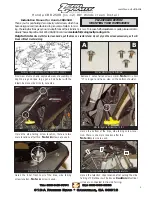
6RL SERIES OPERATION MANUAL
SECTION 6: FRONT PANEL OPERATION
Entire Contents Copyright
2018 by Adaptive Power Systems, Inc. (APS) • All Rights Reserved • No reproduction without written authorization from APS.
6RL Series Regenerative DC Load Operation Manual
Page 97 of 204
Schematic Diagram:
Application and Result:
The function’s primary use is to load a source,
i.e. power supply, which cannot generate the
curve itself and would supply a static DC
voltage. The load acts as a sink for the rapid
fall of the output voltage of the power supply
enabling the voltage progress to follow the
DIN curve. The only requirement for the
source is that it features (an adjustable)
current limitation.
The curve conforms to test impulse 4 of the
DIN. With suitable settings, other test
impulses can be simulated. If the curve in
sequence 4 should be a sine wave, then these
5 sequences would have to be reconstructed
using the arbitrary generator.
6.9.10
Arbitrary Function
The arbitrary (freely definable) function offers the user further scope. There are 99
sequence points are available for use for current I and voltage U, all of which have the same
parameters but which can be differently configured so that a complex function process can
be built up. The 99 sequence points or a part of them can run one after another in a
sequence point block, and this block can then be repeated many times or endlessly. A
sequence point or sequence point block acts only on current or voltage, thus a mix of
assignment to current I or voltage U is not possible.
The arbitrary curve overlays a linear progression (DC) with a sine curve (AC), whose
amplitude and frequency are shaped between start and end values. If the start frequency
(f
s
) = end frequency (f
e
) = 0 Hz, the AC values have no impact and only the DC part is
effective. Each sequence is allocated a sequence time in which the AC/ DC curve from start
to finish will be generated.
The following parameters can be configured for each sequence in the arbitrary function (the
table lists parameters for current, for voltage it would be Us, Ue etc.).
Value
Range
Description
Is(AC)
0...50% Nominal value of I
Start amplitude of the sine wave part of the curve
Ie(AC)
0...50% Nominal value of I
End amplitude of the sine wave part of the curve
fs(1/T)
0 Hz...10000 Hz
Start frequency of the sine wave part of the curve (AC)
fe(1/T)
0 Hz...10000 Hz
End frequency of the sine wave part of the curve (AC)
Angle
0°...359°
Start angle of the sine wave part of the curve (AC)
Is(DC)
Is(AC)...(Nominal value - Is(AC)) of I
Start value of the DC part of the curve
Ie(DC)
Ie(AC)...(Nominal value - Ie(AC)) of I
End value of the DC part of the curve
Seq.time
0.1 ms...36000 s
Time for the selected sequence point
Note: The sequence point time (seq. time) and the start and end frequency are related.
The minimum value for Δf/s is 9.3. Thus, for example, a setting of fs = 1 Hz, fe = 11
Summary of Contents for 6RL Series
Page 203: ......
















































